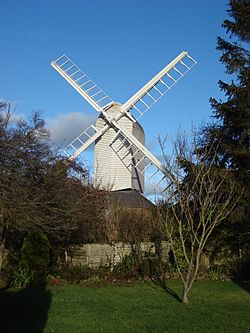Duck End Mill, Finchingfield facts for kids
Quick facts for kids Finchingfield Mill |
|
|---|---|

The restored mill, January 2008
|
|
| Origin | |
| Mill name | Duck End Mill Letch's Mill |
| Mill location | TL 687 329 |
| Coordinates | 51°58′08″N 0°27′14″E / 51.969°N 0.454°E |
| Operator(s) | Essex County Council |
| Year built | Mid-18th century |
| Information | |
| Purpose | Corn mill |
| Type | Post mill |
| Roundhouse storeys | Single storey roundhouse |
| No. of sails | Four sails |
| Type of sails | Spring sails |
| Windshaft | Wood |
| Winding | Tailpole |
| No. of pairs of millstones | One pair |
Finchingfield Mill, also known as Duck End Mill or Letch's Mill, is a historic windmill located in Finchingfield, Essex, England. It is a special type of windmill called a Post mill, and it has been carefully restored. This mill is so important that it is listed as a Grade II building.
Contents
History of Finchingfield Mill
Finchingfield Mill was built in the middle of the 1700s. Records show different dates like 1756, 1760, 1773, and 1777 for its construction. When it was first built, it was an "open trestle" mill. This means the main support structure was open to the elements.
Changes Over Time
In 1840, a "roundhouse" was added to the mill. This is a circular building that covers the base of the mill, protecting its machinery. The mill was used for grinding corn until around 1890.
Originally, the mill had a main shaft, called a "windshaft," made entirely of wood. In the 1950s, this wooden shaft was replaced with a cast iron one from another mill. However, a new wooden windshaft has since been put in place, bringing the mill closer to its original design.
How Finchingfield Mill Works
Finchingfield Mill is a "post mill." This means the entire top part of the mill, including the sails and the machinery, can turn on a large central post. This allows the mill to face the wind from any direction.
Key Parts of the Mill
- Roundhouse: The mill has a single-storey roundhouse at its base. This building helps support the mill and protects the lower parts of its machinery.
- Winding: To turn the mill into the wind, it uses a "tailpole." This is a long pole that extends from the back of the mill to the ground. Workers would push or pull this pole to rotate the mill.
- Sails: The mill has four "spring sails." These sails have wooden frames covered with canvas. They are called "spring sails" because they use springs to help control how much wind they catch.
- Millstones: Inside the mill, there was one pair of "millstones." These heavy stones worked together to grind corn into flour. They were powered by a large "Brake Wheel" that was about 8 feet 8 inches (2.64 meters) across.
The main body of the mill, where the grinding happened, measures about 16 feet 6 inches (5.03 meters) long and 10 feet (3.05 meters) wide.
Visiting the Mill
Finchingfield Mill is open to the public on one Sunday each month during the summer. This gives visitors a chance to see inside a historic windmill and learn how it worked.

